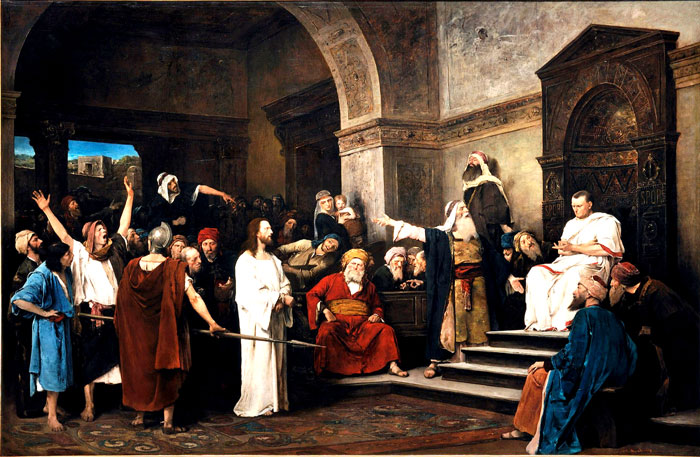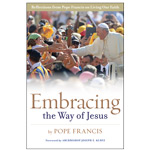The Way of the Cross
Embracing the Way Series
Part Two

Part 2 of the Embracing the Way series looks at the Stations of the Cross as a Lenten tradition as well as a timeless way to imagine Jesus’ journey and grow in our relationship with Him.
The Stations of the Cross are an ancient devotion originating in the desire of Christians to go on pilgrimage to Jerusalem. From the earliest decades the Church in Jerusalem revered the burial grounds and other shrines related to the Way of the Cross. Their devotions were not processions related to the Stations of the Cross as practiced today but did involve a walking pilgrimage to the sacred places related to the crucifixion of Jesus.
In praying the stations we imagine ourselves walking with Jesus on this journey. We then link our reflection to whatever is going on in our lives today.
When we pray the Way of the Cross we follow 14 stations, in the form of 14 pictures, sculptures, or engravings to allow Christians to pause and enter reflectively into those last moments of Jesus’s journey of love.
The Way of the Cross, as it is practiced today, is a devotion that was introduced in late Middle Ages. It is based on the devotion to the Passion of Christ promoted by St. Bernard of Clairvaux (1019–1153), St. Francis of Assisi (1181–1226) and St. Bonaventure (1221–1274). Added to these devotions is the interest and enthusiasm aroused by the Crusades beginning in 1095 which led to the Holy Land becoming the “go to” destination for Christian pilgrims. After 1233 the Franciscans were appointed as custodians of the sacred sites in Jerusalem—a ministry which continues to the present day.
The Stations of the Cross brought together three local devotions begun in Germany and the Netherlands from the fifteenth century onwards. The first was the devotion of Jesus falling beneath the Cross, as many as seven times as practiced by some local communities. The second was the procession between local parish churches in memory of Jesus’ path of sorrow. One path commemorating his walk from the Garden of Gethsemane to the house of the former high priest Annas (John 18:13). Then the walk from the house of Annas to his son-in-law and current high priest, Caiaphas (John 18:24), then to the Praetorian of Pontus Pilate (John 18:28), next to the palace of King Herod (Luke 23:7).
The third devotion follows Jesus’ final walk to the hill of Calvary. There are number of stops along the way. Jesus is forced to stop by his executioners, he falls in fatigue, and he stops to speak to the men and women mourning his suffering. In the local processions these stops are at marked columns or crosses on the path where the faithful stop to meditate in the meaning of Jesus’ final journey for their lives.
There were a number of stations in those years that are not present in the Way of the Cross today. They included Jesus taking leave of his mother Mary, the Washing of the Feet, and the Agony in Garden.
These local devotions were assimilated into the present form of the Way of the Cross, which was created by Franciscan communities in Spain in the last half of the seventeenth century. They spread through Spain and Italy, especially through the work of St Leonard of Port Maurice (1676–1751) who erected Stations of the Cross at more than 572 locations. Most importantly for the whole Church were the Stations he erected in the Roman Colosseum at the request of Pope Benedict XIV in 1750.
Praying the Stations of the Cross
Reflecting on the Stations of the Cross is an exercise in imaginative prayer. They call us to think of more than how Jesus sacrificed himself for our sins: In praying the stations we imagine ourselves walking with Jesus on this journey. We then link our reflection to whatever is going on in our lives today. On our journey we experience both joy, days of stress, and possibly terrible suffering. As members of families and communities we are witnesses to the joys and sufferings of others. Thinking of Jesus on the way to his unjust execution can lead to reflection on his care for the millions throughout the world who lack basic human needs such as clean water, sufficient food, or fundamental human rights.
Here we will reflect on the first and fifth Station of the Cross.
First Station: Jesus Is Condemned to Death
John 18:28–38 tells of this tense confrontation between Jesus, Pilate, and Jesus’ accusers. At one point Pilate asks Jesus “Are you the King of the Jews?” Jesus answered, “Do you ask this on your own, or did others tell you about me?” Basically Jesus is asking Pilate: “Are you bringing me your own questions or questions from someone else?”
As we go through the Stations of the Cross we usually follow a prayer service with reflections and questions. These are meant to give examples of the kinds of questions we can ask for ourselves. So it is important to place ourselves in the scene and bring our own questions of what this means for our life and journey. It is only by bringing our own questions can we pray the Stations in an authentic way.
Fifth Station: Simon of Cyrene Helps Jesus Carry the Cross
Simon of Cyrene is an African, coming from Cyrene, which is in Libya. We do not know what he is doing in Jerusalem; he just seems to be wandering in from the fields. We do not even know if he is Jewish. He is basically conscripted by the Romans to help Jesus carry the Cross. However indifferent Simon is about Jesus when he is pressed into service, it proved to be a life-changing experience for him. In the Gospel of Mark he is identified as “the father of Alexander and Rufus” (Mark 15:21), who were well known in the early Christian community. So Simon came from being someone who lived on the periphery of the community to become a cherished member of the early Church.
How does this relate to our journey? It is easy to be annoyed when asked to volunteer, to be asked to move out of our private comfort zone and become more involved. Perhaps we can pray to Simon of Cyrene to intercede for us so we may discover ways in which we are being called by Jesus to become more cherished members of our parish community.
The Insights of Pope Francis
Do you want to be like Pilate, who did not have the courage to go against the tide to save Jesus’ life, and instead washed his hands? Tell me: are you one of those who wash their hands, who feign ignorance and look the other way? Or are you like Simon of Cyrene, who helped Jesus to carry that heavy wood, or like Mary and the other women, who were not afraid to accompany Jesus all the way to the end, with love and tenderness? And you, who do you want to be? Like Pilate? Like Simon? Like Mary? Jesus is looking at you now and is asking you: do you want to help me carry the Cross? Brothers and sisters, with all the strength of your youth, how will you respond to him?
Address at the 28th World Youth Day, Rio de Janeiro, 26 July 2013
Scripture quotations are from the New Revised Standard Version Bible: Catholic Edition, copyright © 1989, 1993 National Council of the Churches of Christ in the United States of America.
Image Credit: Mihály Munkácsy, Christ in front of Pilate, 1881. Oil on canvas, Déri Museum, Debrecen. Public domain, via Wikimedia Commons.
Embracing the Way series
Embracing the Way by James P. Campbell, D.Min. is a six-part web series that includes:
Part 5: Mary: Mother and Companion in the Way
Part 6: The Way of Human Dignity
Embracing the Way of Jesus

This series is based on Embracing the Way of Jesus by Pope Francis, edited and compiled by James P. Campbell.
Embracing the Way of Jesus is a beautifully curated collection of excerpts from the homilies and writings of Pope Francis, all centering on Christianity as a way of life—or, as the earliest Christians would have understood it, “the Way.” Through the Pope’s meditations on Scripture, we pause to consider essential aspects of discipleship.


